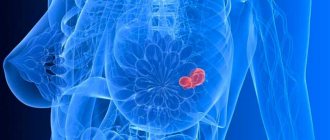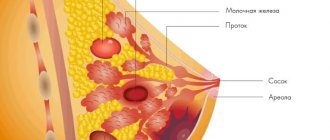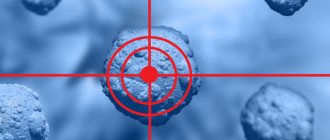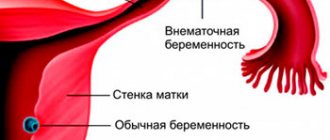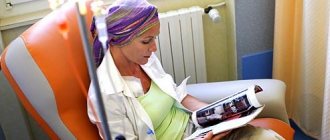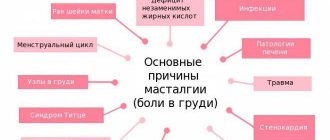Many women turn to specialists with the question of whether breast cancer hurts and what are the symptoms of this disease. Malignant breast tumors are common among modern women, so various treatment regimens have been developed for this disease. By contacting specialists at the Yusupov Hospital for oncology treatment, you will receive high-quality care and support.
Symptoms of breast cancer
A malignant tumor localized in the breast quickly increases in size and its cells spread throughout the body. This disease is difficult to diagnose independently at an early stage, but high-precision equipment makes it possible to identify primary lesions. Some women, after conducting a self-examination and discovering a lump in the breast, ask specialists whether a breast cancer tumor hurts.
The main signs of a malignant breast tumor are:
- chest pain and discomfort;
- lumps in the breast, changes in its shape;
- changes in the skin: peeling, redness, retraction, hardening;
- nipple deformation;
- enlarged lymph nodes;
- bloody discharge from the nipple.
Regular visits to a mammologist are an important measure for the early detection of breast tumors. If these clinical manifestations occur, you should contact a medical facility for examination. Important advantages of the diagnostic center of the Yusupov Hospital are: no queues, highly accurate results and friendly staff.
What is mastalgia
Breast pain, also known as mastalgia, mastodynia or mammalgia, is a fairly common complaint found among women. Almost 70% of women will experience this pain at some point in their lives. It can occur in one or two glands at the same time. Women often describe it as: unbearable pain, constant dull ache, burning inside or increased sensitivity when touching the breasts. Approximately 15% of women require treatment to relieve this pain.
If the appearance of pain has a clear connection with menstruation, it is called cyclic mastalgia. This type of pain usually appears three days before your period starts and becomes less intense when it stops. Most often, mastalgia occurs in the upper outer quadrant of the mammary gland, and can sometimes spread to the arm.
Mastalgia is less common in older (postmenopausal) women than in younger women.
Cyclic and non-cyclic mastalgia
Chest pain is usually divided into “cyclical” (repeating) and “non-cyclical” (constant).
Signs of cyclic pain:
- the pain is irregular;
- the breast becomes “sensitive”;
- some women characterize it as a dull pain, others as a bursting soreness or tingling and burning sensation in the gland;
- the breast “swells” and becomes dense (“one solid hard lump”);
- as a rule, both breasts are affected, especially their upper-outer sections;
- pain may spread to the armpit area;
- intensifies a few days before the onset of menstruation, sometimes appears two weeks before menstruation;
- occurs in young women, but may occur in women who receive hormones.
Signs of non-cyclic pain:
- occurs in only one breast, usually in one quadrant of the breast, but can spread to the entire breast;
- more common among postmenopausal women;
- no connection with the menstrual cycle;
- the pain may be constant or occur sporadically.
Mastitis is an infectious inflammation of the mammary gland. In women, it may be accompanied by fever and malaise. The mammary gland becomes swollen, in the place of greatest pain you can detect an increase in temperature, and there may also be redness. The pain, as a rule, acquires a burning character. For breastfeeding mothers, the pain becomes more intense during feeding.
Extramammillary pain is felt in the breast, but the source of this pain is elsewhere. It is sometimes called “radiating pain.” It occurs against the background of certain diseases of the chest wall, such as costochondritis (inflammation of the joint of the ribs with the sternum, where there is cartilage).
Diagnosis of mastalgia
If the woman is young (not in menopause), the doctor will first try to find out whether the breast pain may be cyclical. To do this, he will probably ask:
- how much caffeine she consumes;
- location of pain;
- pain in one gland or two;
- does she smoke;
- is using medications or combined contraceptive pills;
- could she be pregnant;
- whether there are other symptoms, such as nipple discharge or breast masses.
The doctor will listen to the patient's lungs and heart, and also examine her chest and abdomen to rule out other possible diseases.
The doctor will examine the mammary glands and determine if there are any formations in them, changes in the nipples, changes in the skin of the mammary glands, and will also check the lymph nodes located in the lower neck and in the armpit area to make sure they are not enlarged.
If the detected “ball” in the breast moves, does that mean it’s not cancer? In the early stages, cancer usually does not grow into nearby tissues, that is, it is “mobile.” This is a good sign, because cancers that are “fixed” to the skin or chest wall are a sign of later stages of cancer.
If the doctor finds a tumor or a “suspicious” lump in the mammary gland, and also if the gland tissue causes severe pain upon palpation, he may prescribe additional tests:
- Mammography - X-ray examination of the breast.
- Ultrasound - ultrasound examination of the breast. Even if a mammogram reveals nothing, an ultrasound scan is usually performed, as it is considered more informative than a mammogram for some tumors.
- Breast biopsy (or fine-needle aspiration, or trephine biopsy, or open biopsy) if suspicious formations in the mammary gland are identified. The doctor will take a small piece of breast tissue and send it to a laboratory for analysis.
Diagnosis of a malignant breast tumor
If a lump appears in the breast area and any symptoms of a tumor, you should not delay visiting an oncologist. Specialists at the Oncology Clinic of the Yusupov Hospital are always ready to answer patients’ questions about whether breasts hurt with cancer and what are the manifestations of the pathological process.
Diagnostics using high-precision equipment carried out at the Yusupov Hospital is aimed at identifying lesions of the mammary glands and secondary lesions. Diagnostic measures for suspected breast cancer include:
- visual examination performed by an oncologist;
- feeling the chest;
- X-ray examination or mammography of the mammary glands;
- determination of estrogen levels;
- tumor markers;
- immunohistochemical study;
- breast tomography;
- tissue biopsy.
Early diagnosis of a malignant breast tumor increases the likelihood of a favorable outcome of the disease. During the appointment, highly qualified specialists at the Yusupov Hospital not only answer the patient’s question about whether breast cancer hurts, but also prescribe diagnostic measures to confirm or refute the diagnosis.
Notifications
Obese women are also at risk of developing the disease, because obesity produces hormones that lead to cancer. Alcohol consumption and fat-rich diets are dangerous. Women who have suffered chest injuries are also at risk.
— Does wearing bras with underwires, for example, affect breast cancer? And then there is this opinion...
- There is no obvious connection in this. Many women wear such bras and nothing. I have not observed such a pattern and have not heard about such things.
— Does breast size affect it?
- Doesn't have any effect. It even occurs in men, but extremely rarely, 5–7 cases per year. The source of breast cancer is not the fatty tissue of the organ, but the glandular tissue, the one where, simply put, milk is formed.
- And in men, what causes it?
- The risk factors are the same - obesity, injuries, alcohol consumption. Especially beer in large quantities - it contains the hormone estrogen. In men, this glandular tissue develops.
— Is there any connection between breast cancer and the birth of a child?
- For example, if a woman is diagnosed with breast cancer at the age of 30, and she does not have a child, then for the next 5 years there will be a contraindication for having one. Everyone forgets about this. There will be aggressive treatment, after which the body must recover. And by the age of 40, the risk of having a child with genetic diseases increases.
Treatment of breast cancer at Yusupov Hospital
The many years of experience of oncologists at the Yusupov Hospital and mastery of modern technologies allow them to provide breast cancer treatment that meets international standards. Patients of the Yusupov Hospital have a unique opportunity to receive quality treatment while in Russia.
Depending on the form of the disease and the characteristics of its course, the oncology clinic of the Yusupov Hospital uses the following for the treatment of breast cancer:
- chemotherapy using effective drugs. Chemotherapy treatment, depending on the goals of therapy, can be carried out before surgery or after tumor removal;
- radiation therapy aimed at destroying affected cells;
- surgical removal of a malignant tumor;
- targeted therapy;
- hormonal treatment aimed at reducing the production of female sex hormones.
Patients diagnosed with a breast tumor are interested in what to take for pain. Specialists at the Yusupov Hospital select effective medications to eliminate symptoms that place minimal stress on the body.
Patients at the Yusupov Hospital have access to modern methods for diagnosing oncological diseases, in which studies are carried out in the shortest possible time. Specialists at the Oncology Clinic give preference to organ-preserving methods if they are possible in cases of identified breast cancer. During the treatment process, women receive not only medical, but also psychological assistance.
Women, if any symptoms appear, should not search for an answer to the question of whether a breast tumor hurts and self-medicate. By contacting oncologists at the Yusupov Hospital, you can be confident in the qualifications of the staff and the quality of diagnostic and therapeutic measures.
Author
Yulia Vladimirovna Kuznetsova
Oncologist
Possible causes of pain
Sometimes it can be difficult to determine the cause of chest pain. To give an idea of how difficult this task is for a physician, the following are possible factors associated with its occurrence:
- acid reflux;
- alcoholism with liver damage;
- angina pectoris;
- anxiety, stress and depression;
- benign tumors;
- bronchiectasis;
- breast cyst;
- chest wall surgery;
- breastfeeding (possible infection);
- cervical and thoracic spondylosis/radiculopathy;
- cardiac ischemia;
- costochondritis;
- fibrocystic mastopathy;
- mammary cancer;
- diet (especially caffeine);
- fibromyalgia;
- herpes zoster;
- mastitis;
- medications, including digitalis preparations, chlorpromazine, some diuretics, spironolactone, methyldopa;
- peptic ulcer;
- pericarditis;
- pleurisy;
- pregnancy;
- mental disorders;
- pulmonary thromboembolism;
- rib fracture;
- shingles;
- sickle cell anemia;
- chest wall injury.
If a tumor in the mammary gland does not hurt, does that mean it is not cancer? 3% of women who see a doctor about a painful breast lump will be diagnosed with breast cancer. The presence of pain should not be reassuring. Any woman who discovers a new “ball” in her breast should consult a doctor!
We recommend reading the article about breast carcinoma. How carcinoma is diagnosed, what factors can contribute to the onset of the disease, what symptoms indicate carcinoma, you can read in more detail in this article.
Bibliography
- ICD-10 (International Classification of Diseases)
- Yusupov Hospital
- Cherenkov V. G. Clinical oncology. — 3rd ed. - M.: Medical book, 2010. - 434 p. — ISBN 978-5-91894-002-0.
- Shirokorad V.I., Makhson A.N., Yadykov O.A. The state of oncourological care in Moscow // Oncourology. - 2013. - No. 4. - P. 10-13.
- Volosyanko M.I. Traditional and natural methods of preventing and treating cancer, Aquarium, 1994
- John Niederhuber, James Armitage, James Doroshow, Michael Kastan, Joel Tepper Abeloff's Clinical Oncology - 5th Edition, eMEDICAL BOOKS, 2013
How to get rid of pain
You should start taking any medications only after a comprehensive examination and under the supervision of a doctor. There are two types of pain medications: narcotic and non-narcotic drugs.
- Narcotic analgesics: Promedol, Fentanyl, Omnopon, Tramadol.
- Non-narcotic analgesics or non-steroidal anti-inflammatory drugs: Ibuprofen, Ketanov, Nimesulide, Meloxicam, Diclofenac.
The choice of drug for oncology depends on the nature of the pain, its intensity and the cause of the pain syndrome. According to the recommendations of the World Health Organization, there are three stages of pain relief for cancer. For mild pain, non-narcotic analgesics are used. For moderate intensity, weak opiates are prescribed. For high intensity pain, use narcotic pain relief.
https://youtu.be/dcwubRRQDPY
Signs of metastases
The appearance of metastases is a sure sign of progressive cancer. This means that cancer cells have spread beyond the breast and are beginning to spread to other tissues and organs.
Cancer spreads through the blood and lymph. In this case, pain may occur in the axillary and peri-thoracic lymph nodes, and the lymph nodes significantly increase in size. Then the cervical, subclavian and subscapular lymphatic vessels are gradually affected.
With the help of blood circulation, metastases can spread to any organ or part of the body. How breast cancer manifests itself during metastases largely depends on the area affected.
The range of symptoms that arise is very wide:
- yellowing of the skin, enlarged liver, nausea;
- cough, shortness of breath, bloody sputum with lung damage;
- musculoskeletal pain, bone fragility;
- migraines, pathological changes in the psyche.
Risk factors
Unfortunately, the current level of development of medicine does not suggest the exact reasons contributing to the occurrence of breast cancer. An important task for a woman is to independently determine the first symptoms of breast cancer.
However, statistics have made it possible to identify a number of factors in which the risk of developing cancer is especially high:
- Personal medical history: diabetes, gynecological diseases, injuries and diseases of the mammary glands (such as mastitis, mastopathy, fibroadenoma).
- Presence of cancer in close relatives.
- Age. Typically, the risk of various types of breast cancer increases from age 45 and is especially high after age 60.
- Radiation therapy to the chest organs.
- Living in an area with poor ecology.
- Early or late menopause.
- Work night shifts.
- Systematic stress.
- Overweight, smoking and alcoholism.
What types of pain do you experience with cancer?
When the question arises: “ Does cancer hurt?
?”, you need to take into account the fact that there are three types of pain during the oncological process:
- Acute pain. It is caused by sudden damage, such as trauma, compression of organs by a neoplasm. Acute pain often indicates neglect of the situation and metastasis. can be kept under control with painkillers prescribed by your doctor. Pain that goes untreated can become chronic.
- Chronic pain is caused by nerve damage. Some changes occur due to pressure in the tumor produced by chemicals. They are produced by the cancers themselves. The pain can range from mild to severe.
- Radiating pain is a feeling of soreness in a place distant from the tumor. For example, a swollen liver may cause pain in the right shoulder. This condition is associated with nerve endings.
What can cause chest pain
If a woman is of childbearing age, and the pain spreads to the entire chest, reminiscent of muscle fatigue, then most likely the cause is hormonal imbalance. They cause enlargement and swelling of the glands, which is why such an unpleasant sensation appears. A similar situation occurs when a young person matures and turns into a girl, or at the onset of the menstrual cycle, menopause and pregnancy.
In addition, the cause of chest pain can be herpes zoster and various infections.
What should be the first steps for pain in the mammary gland?
The very first thing you need to do is calm down and adequately assess the situation. Remember the last time you had your period and make sure you are not pregnant. Conduct an independent examination of the breast, carefully feel it for formations. Assess the condition of the skin and nipples. Be sure to consult a gynecologist. The specialist, in turn, will palpate the breast, direct the patient to undergo tests, a mammogram and, if necessary, a biopsy and tumor markers.
As a preventive measure, every woman is required to undergo a gynecological examination every six months. Control your hormonal levels and monitor the regularity of your menstrual cycle. Coordinate with your doctor the use of hormonal medications, and especially their dosage. At the first warning signs and suspicions, immediately contact specialists.
Causes of pain syndrome
- Due to the increase in the size of the cancerous tumor, the skin is affected and changes, on which wounds and ulcers form. Pain sensations range from mild to moderate intensity.
- As a result of damage to the body by metastases, discomfort appears in the organs affected by cancer cells, and their functionality is impaired.
- Pain syndrome may occur as a result of medical procedures. This is explained by the response of a weakened body to radiation or hormonal drugs - the tumor tissue is destroyed, and the chest hurts. Discomfort may occur during chemotherapy and the recovery period.
